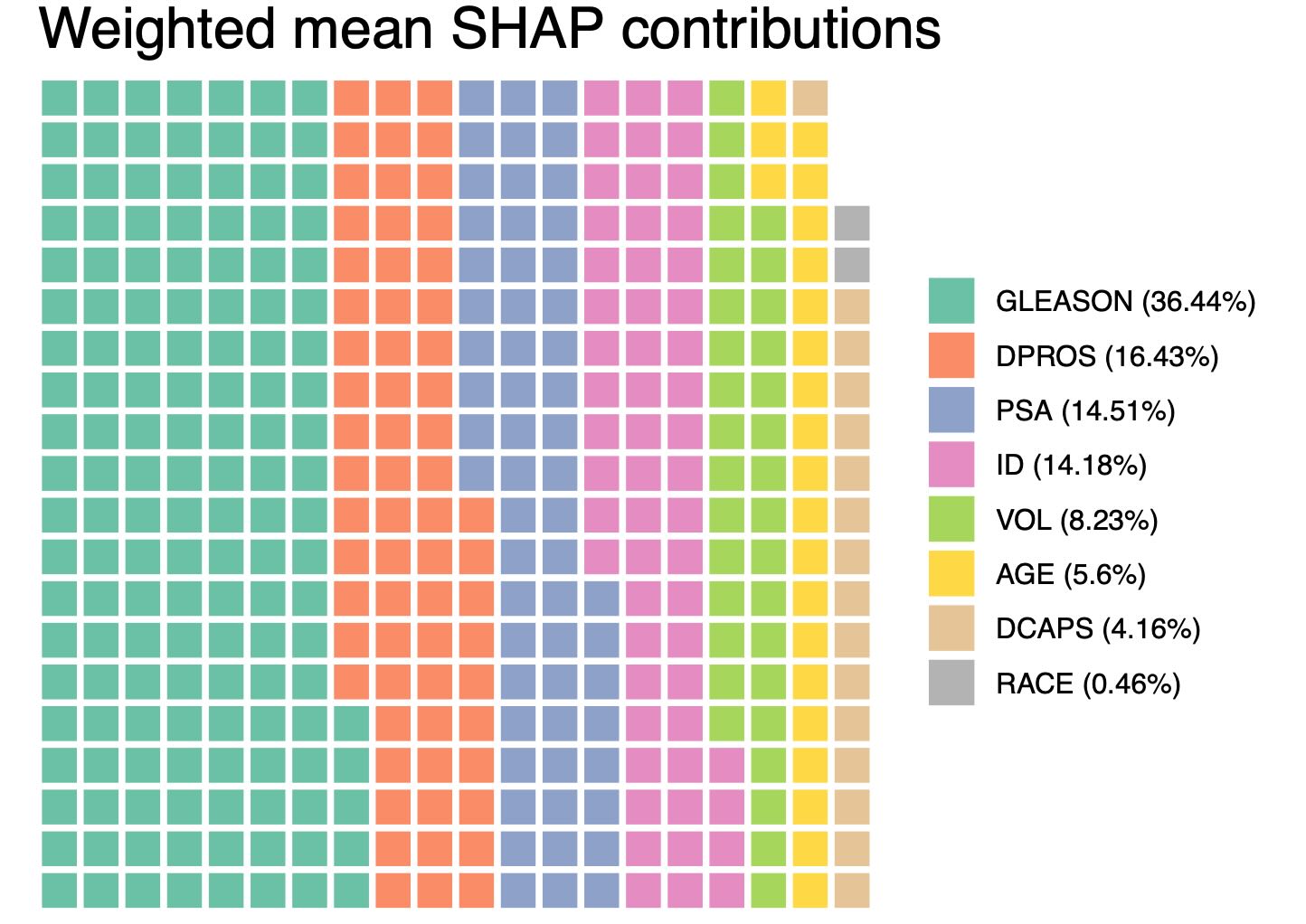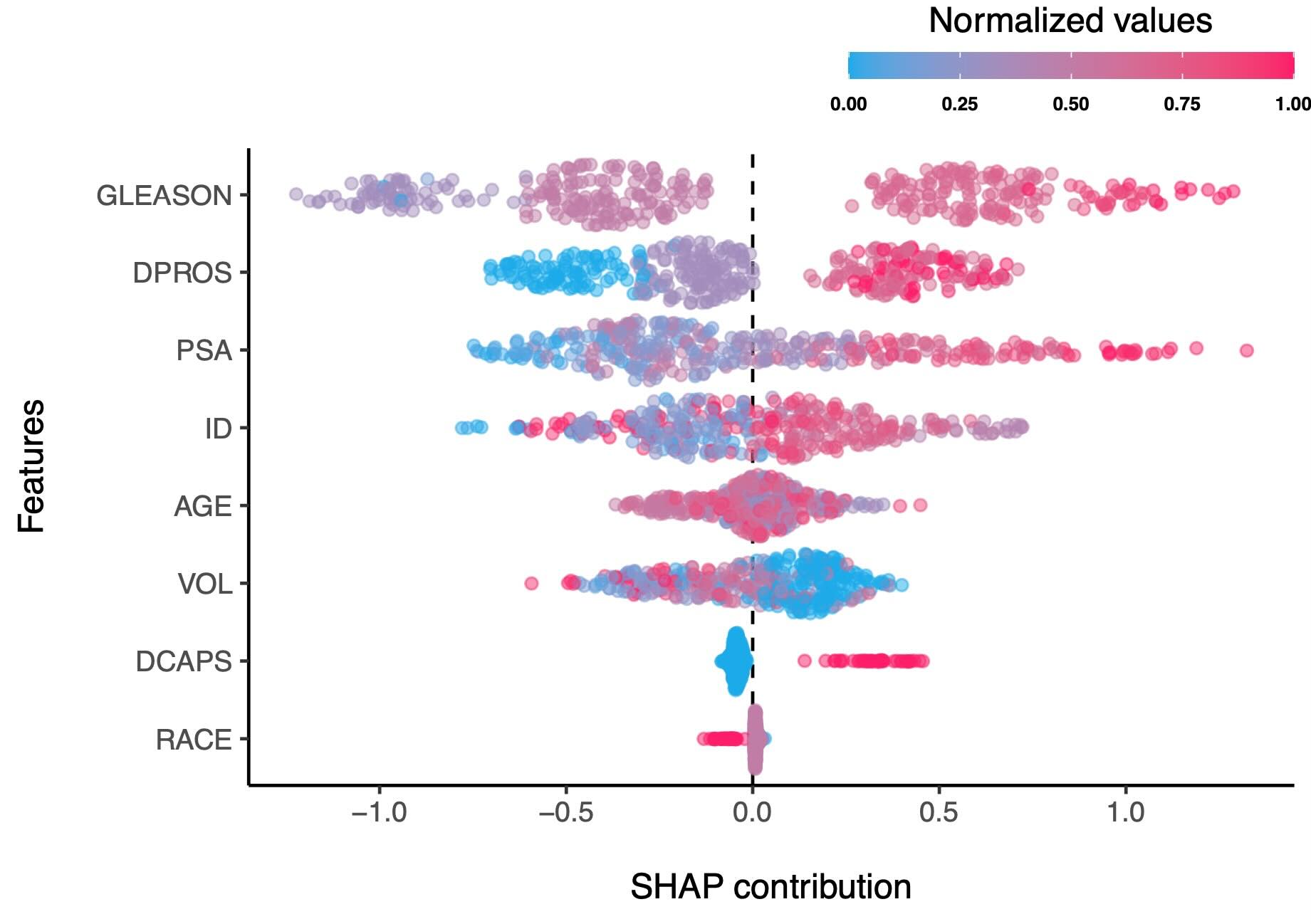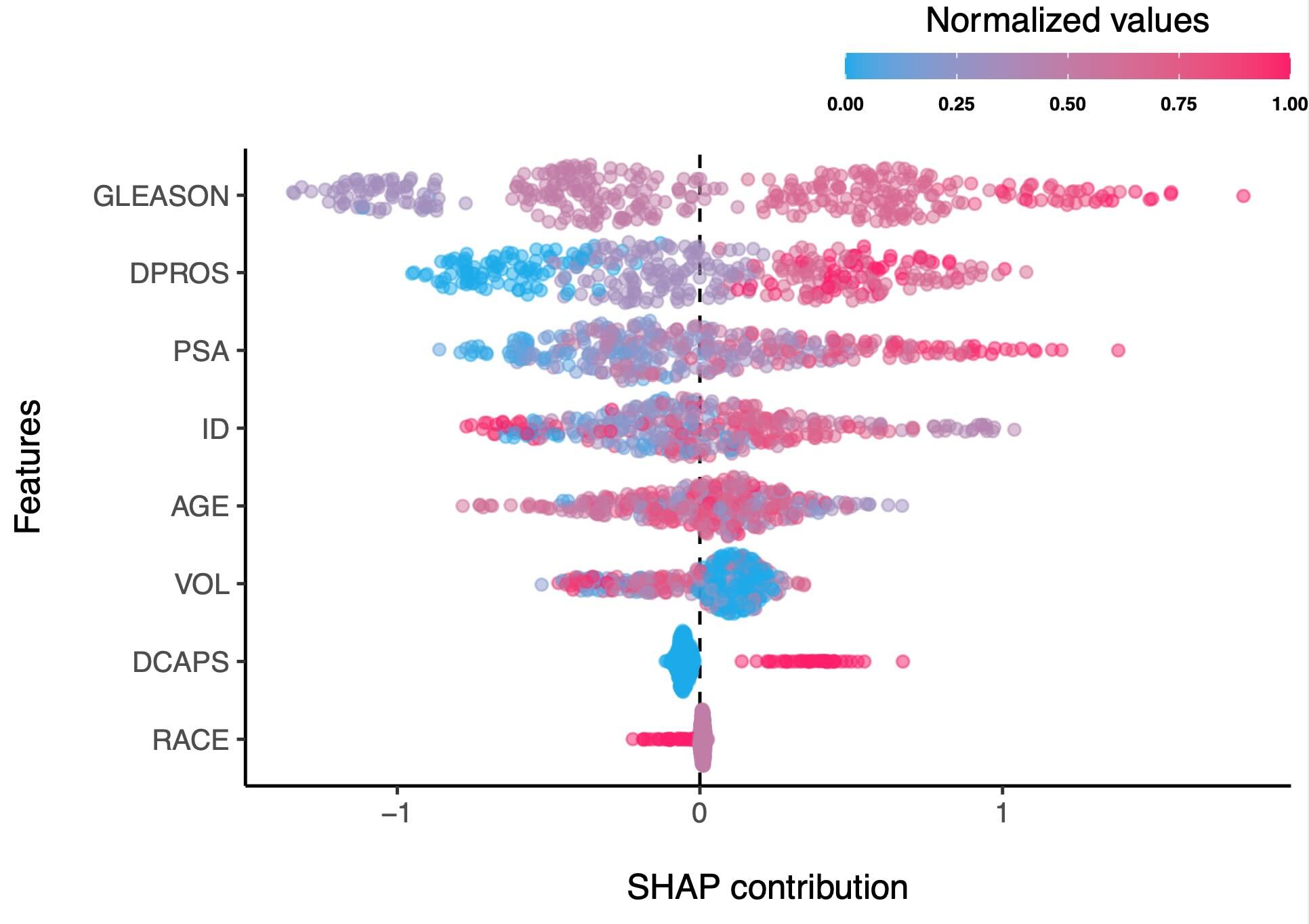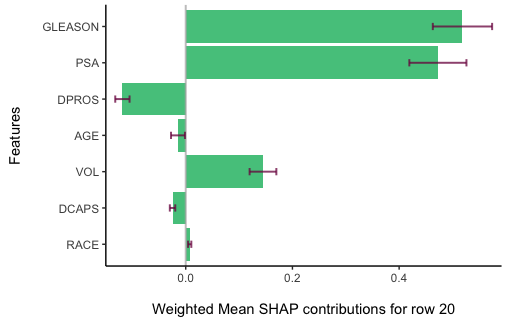
The hardware and bandwidth for this mirror is donated by METANET, the Webhosting and Full Service-Cloud Provider.
If you wish to report a bug, or if you are interested in having us mirror your free-software or open-source project, please feel free to contact us at mirror[@]metanet.ch.
- Citation: Haghish, E. F. (2023). shapley: Weighted Mean SHAP for Feature Assessment in ML Grid and Ensemble [computer software]. URL: https://CRAN.R-project.org/package=shapley
- - -
shapley
: Weighted Mean SHAP for Automatic and Robust Feature Importance
Assessment and Selection in Machine Learning Grid and EnsembleThe shapley R package addresses a significant limitation
in exploratory machine learning research by providing a method
to calculate the weighted mean ratio and confidence intervals
of SHapley Additive exPlanations, commonly known as
SHAP values across machine learning grids and stacked
ensemble models. This approach enhances the stability and reliability of
SHAP values, making the determination of important features more
transparent and potentially more reproducible. Traditionally, the focus
has been on reporting SHAP values from a single ‘best’ model, which can
be problematic under conditions of severe class imbalance, where a
universally accepted ‘best’ model may not exist. In addition, models
with different parameters, might result in different evaluations of SHAP
contributions and such variablity is also meaningful for researchers who
wish to understand important features relevant to a model. In other
words, SHAP values are unstable and varry across models, a limitation
that is often overlooked in the literature by reporting the SHAP
contributions of the ‘best’ model. In such scenarios, the SHAP values
from a single model may not be representative of other models. The
shapley package fills a critical gap by proposing
methodology and enabling the computation of SHAP values for multiple
machine learning models such as a fine-tuning grid search, and stacked
ensemble models. This method computes weighted mean SHAP contributions,
considering the performance of the model, to compute more stable SHAP
values that also reflect of the variations across models.
In particular, the shapley software addresses the
following shortcomings, often found in recent literature of applied
machine learning:
The instability of SHAP values reported from single models is a concern, especially when the model’s performance and the variability of SHAP values across multiple fine-tuned models are not taken into account. With the increase in severity of class imbalance, the instability is expected to increase, because the definition of “best model” becomes less reliable due to lack of global performance metric that is not biased to class imbalance.
There is an absence of standardized methods for calculating SHAP values for stacked ensemble models or for determining the SHAP contributions of features within the entirety of models resulting from a tuned grid search.
There is a notable gap in methods for computing confidence intervals for SHAP values. Such intervals are necessary for significance testing to determine if one feature’s importance is statistically greater than that of another. They also would reflect the variability between how different models reflect on SHAP values of different features.
The practice of identifying “top features” often relies on an arbitrary selection of a predefined number of features, such as the top 10 or top 20, without a standard methodological approach. There is a need for a more transparent and automated procedure for quantifying and identifying important features in a model.
shapley R packageThe shapley R package computes the weighted average and
confidence intervals of Shapley values from multiple machine learning
models. By incorporating model performance metrics as weights, it
addresses the variability in SHAP values across different models, which
is often overlooked when relying on a single “best” model. This approach
is particularly valuable in situations where defining the best model is
challenging, such as with severe class imbalances (class rarity, caused
by low-prevalence outcome). The package also facilitates more reliable
computation of SHAP contributions across models and provides a basis for
significance testing between features to ensure differences are not due
to random chance. Furthermore, the package proposes several automated
and transparent methods for identifying important features. These
methods use various metrics to define importance, allowing for the
selection of significant features based on SHAP contributions without
pre-specifying number of top features (see below for details).
The shapley algorithm computes weighted mean SHAP values and their 95% confidence intervals for a set of homogeneous or heterogeneous machine learning models. The algorithm also computes mean and 95% confidence interval bootstrap SHAP values for a single model. Local SHAP values are at subject level (n) and global SHAP contributions are at feature level (p).
To demonstrate how shapley can compute
SHAP values across a machine learning grid, let’s carry out a grid
search to fine-tune Gradient Boosting Machines (GBM) algorithm for a
binary classification. Next, I will use the grid to compute SHAP
contributions across all models and report their weighted mean and
weighted 95% confidence intervals.
library(h2o) #shapley supports h2o models
library(shapley)
# initiate the h2o server
h2o.init(ignore_config = TRUE, nthreads = 2, bind_to_localhost = FALSE, insecure = TRUE)
# upload data to h2o cloud
prostate_path <- system.file("extdata", "prostate.csv", package = "h2o")
prostate <- h2o.importFile(path = prostate_path, header = TRUE)
# run AutoML to tune various models (GBM) for 60 seconds
y <- "CAPSULE"
prostate[,y] <- as.factor(prostate[,y]) #convert to factor for classification
set.seed(10)
#######################################################
### PREPARE H2O Grid (takes a couple of minutes)
#######################################################
# make sure equal number of "nfolds" is specified for different grids
grid <- h2o.grid(algorithm = "gbm", y = y, training_frame = prostate,
hyper_params = list(ntrees = seq(1,50,1)),
grid_id = "ensemble_grid",
# this setting ensures the models are comparable for building a meta learner
seed = 2023, fold_assignment = "Modulo", nfolds = 10,
keep_cross_validation_predictions = TRUE)
result <- shapley(grid, newdata = prostate, performance_metric = "aucpr", plot = TRUE)In the example above, the result object would be a
list of class shapley, which in cludes the
information such as weighted mean and weighted confidence intervals as
well as other metrics regarding SHAP contributions of different
features.
You can use the shapley.plot function
to plot the SHAP contributions:
shapley object, in this
example, named result, and specify "bar", to
create a bar plot:shapley.plot(result, plot = "bar")
Another type of plot, that is also useful for identifying important
features is waffle plot, by default
showing any feature that at least has contributed 0.25% to the overall
explained SHAP values across features.
shapley.plot(result, plot = "waffle")
Another type of plot is shap plot,
which shows the SHAP contributions of each feature for each observation
(subject, or row in the data). This plot is useful for identifying the
direction of the effect of each feature on the outcome, improving the
transparency of the model. What is noteworthy about the
shap plot is that it visualizes the
weighted mean SHAP contributions across all models, while taking the
performance of the models into account. Therefore, this plot is expected
to provide more stable SHAP explanations that how different values of a
feature affect the outcome.
shapley.plot(result, plot="shap")Note: the weighted mean SHAP contribution plot of observations is expected to more clearly differentiate between how different values of a feature affect the outcome.

For instance, in the plot above, the effect of “GLEASON” feature on the outcome is more clearly differentiated between different values of the feature, compared to the plot of SHAP contributions of a the best model, as shown below. As you see, subjects with very high SHAP values that are shown in the best model below are not present in the plot of weighted mean SHAP contributions, meaning that different models did not agree on the effect of “GLEASON” feature on the outcome and thus, the voice of different models is taken into account, weighted by their performance metric. It is also evident that the SHAP contributions of the weighted mean SHAP model are more clearly demonstrate the relationship of the feature on the outcome. See for example, the ‘DPROS’ feature, where the SHAP values are somehow well-clustered in the weighted mean SHAP plot, indicating that collectively, the models clearly see a pattern between increased intensity of ‘DPROS’ with the outcome.

Weighted mean SHAP values and their confidence intervals can also be
computed for Factors (A group of items) or
Domains (A group of correlated or related factors
presenting a domain). For both, the domain argument should
be specified so that the software compute the contribution of a cluster
of items. There is no difference between Factors and
Domains, because for either, they need to be defined as a group
of features (variables / columns) in the dataset.
print(shapley.domain(shapley = result,
plot = "bar", method = "mean",
domains = list(Demographic = c("RACE", "AGE"),
Cancer = c("VOL", "PSA", "GLEASON"),
Tests = c("DPROS", "DCAPS")),
print = TRUE))
The analysis results are also returned in a Table:
domain mean sd ci lowerCI upperCI
1 Demographic 0.09730516 0.01304978 0.004669805 0.09263535 0.1019750
2 Cancer 0.70783878 0.01747264 0.006252502 0.70158628 0.7140913
3 Tests 0.19485606 0.01269251 0.004541957 0.19031411 0.1993980You can also compute weighted mean SHAP values for each subject (row)
in the dataset. To do that, use the shapley.row.plot
function. For example, to view the SHAP contributions and their
confidence intervals for the 20th row in the dataset, type:
shapley.row.plot(result, row_index = 20)
The bar plot displays the weighted average and confidence intervals
for the SHAP contributions of various features, implying whether
differences between two features might be due to random variation. To
further investigate the statistical significance of these differences,
the shapley.test function can be employed. This function
uses a permutation test, typically with a default of 5000 permutations,
to assess significance. For instance, to determine if the observed
difference in SHAP contributions between the “GLEASON” and “DPROS”
features is not just a random occurrence, we would use this
function.
shapley.test(result, features = c("GLEASON", "DPROS"), n = 5000)The difference between the two features is significant:
observed weighted mean Shapley difference = 150.014579392817 and p-value = 0
$mean_shapley_diff
[1] 150.0146
$p_value
[1] 0However, if we check the difference between “PSA” and “ID” features, the difference is insignificant, although “PSA” has a slightly higher weighted mean SHAP contribution:
shapley.test(result, features = c("PSA", "ID"), n = 5000)The difference between the two features is not significant:
observed weighted mean Shapley difference =2.44791199071206 and p-value = 0.678
$mean_shapley_diff
[1] 2.447912
$p_value
[1] 0.678Note: the weighted confidence intervals showed in the bar plot do not apply any permutation test.
Traditionally, the selection of a set number of significant features based on the highest SHAP values varied across scientific publications, with some reporting the top 10, 15, or 20. This selection did not account for the variability between models and often was either an arbitrary number. Other papers reported feature importance of all features, which is not practical for large datasets, and also, doesn’t consider if features with neglegible SHAP contributions are statistically significant, given the variability across models.
However, the calculation of weighted means and 95% confidence
intervals allows for a systematic approach to identify features that
consistently contribute to the model, across different models. For
instance, the default method in the shapley package
considers features important if their weighted mean shap ration exceeds
the specified cutoff. Another alternative is “lowerCI”,
which selects features that their lower bound of their weighted 95%
confidence interval for the WMSHAP exceeds the cutoff. This means any
feature with a stable relative contribution above the cutoff is deemed
important. This method is also utilized in the bar plot,
where features are ranked by their weighted mean SHAP values, and the
cutoff is applied to the lower confidence interval.
This is demonstrated in the waffle plot, where features
must contribute at least 0.5% to the overall weighted mean SHAP values
to be selected.
Between the “lowerCI” and “mean” methods,
each has merits and limitations. “LowerCI” is more
conservative, while “mean” focuses on the weighted mean
shap ratios.
In this regard, the package also suggests a function for testing
different criteria. Currently, implementing only lowerCI
and mean criteria. following the examples above, the
shapley.top shows features that pass
different criteria:
# running shapley.top with defult values for the 'result' object
shapley.top(result, lowerCI = 0.01, mean = 0.005) feature lowerci shapratio lowerCI_criteria shapratio_criteria
1 AGE 0.13241618 0.056009832 TRUE TRUE
2 DCAPS 0.09566612 0.041606347 TRUE TRUE
3 DPROS 0.39986992 0.164283698 TRUE TRUE
4 GLEASON 0.89025073 0.364372706 TRUE TRUE
5 ID 0.33566464 0.141787423 TRUE TRUE
6 PSA 0.34900145 0.145052440 TRUE TRUE
8 VOL 0.19571663 0.082300782 TRUE TRUE
7 RACE 0.01079821 0.004586772 TRUE FALSEwhich shows the features that pass both or one of the criteria. There is, however, a need for further research to suggest optimal cutoff values or reach a better perspective that what aspects should be taken into consideration for suggesting optimal cutoff values.
Stacked ensemble models integrate multiple base learner models’
predictions, assigning weights according to each base model’s
performance. The methodology implemented in shapley
software employs a similar approach, calculating the weighted mean SHAP
contributions for stacked ensemble models just as it would for a
fine-tuned grid of models. The shapley function’s
models parameter automatically detects whether the input is
an h2o grid or an h2o or
autoEnsemble stacked ensemble, eliminating the need for
users to identify the model object class.
The package is compatible with machine learning grids or stacked
ensemble models created using the h2o
package, as well as the autoEnsemble
package in R.
The methodology implemented in this software as well as the software itself was developed by E.F. Haghish, who is a researcher at Department of Psychology, University of Oslo, researching applications of machine learning for mental health.
Twitter: @haghish
These binaries (installable software) and packages are in development.
They may not be fully stable and should be used with caution. We make no claims about them.